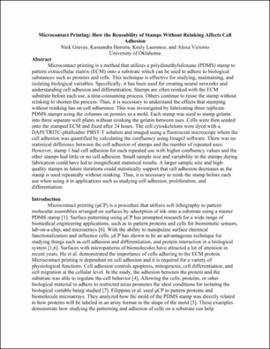| dc.contributor.author | Graves, Nick | |
| dc.contributor.author | Herrera, Kassandra | |
| dc.contributor.author | Laurence, Keely | |
| dc.contributor.author | Victorio, Alexa | |
| dc.date.accessioned | 2022-06-23T12:37:39Z | |
| dc.date.available | 2022-06-23T12:37:39Z | |
| dc.date.issued | 2022 | |
| dc.identifier.uri | https://hdl.handle.net/11244/335877 | |
| dc.description.abstract | Microcontact printing is a method that utilizes a polydimethylsiloxane (PDMS) stamp to pattern extracellular matrix (ECM) onto a substrate which can be used to adhere to biological substances such as proteins and cells. This technique is effective for studying, maintaining, and isolating biological variables. Specifically, it has been used for creating neural networks and understanding cell adhesion and differentiation. Stamps are often reinked with the ECM substrate before each use, a time-consuming process. Others continue to reuse the stamp without reinking to shorten the process. Thus, it is necessary to understand the effects that stamping without reinking has on cell adherence. This was investigated by fabricating three replicate PDMS stamps using the columns on pennies as a mold. Each stamp was used to stamp gelatin into three separate well plates without reinking the gelatin between uses. Cells were then seeded onto the stamped ECM and fixed after 24 hours. The cell cytoskeletons were dyed with a DAPI/TRITC-phalloidin/ PBST-T solution and imaged using a fluorescent microscope where the cell adhesion was quantified by calculating the confluency using ImageJ software. There was no statistical difference between the cell adhesion of stamps and the number of repeated uses. However, stamp 1 had cell adhesion for each repeated use with higher confluency values and the other stamps had little or no cell adhesion. Small sample size and variability in the stamps during fabrication could have led to insignificant statistical results. A larger sample size and high-quality stamps in future iterations could statistically support that cell adhesion decreases as the stamp is used repeatedly without reinking. Thus, it is necessary to reink the stamp before each use when using it in applications such as studying cell adhesion, proliferation, and differentiation. | en_US |
| dc.language | en_US | en_US |
| dc.rights | Attribution 4.0 International | * |
| dc.rights.uri | https://creativecommons.org/licenses/by/4.0/ | * |
| dc.title | Microcontact Printing: How the Reusability of Stamps Without Reinking Affects Cell Adhesion | en_US |
| dc.type | Article | en_US |
| dc.description.peerreview | No | en_US |
| ou.group | Gallogly College of Engineering::Stephenson School of Biomedical Engineering | en_US |
| dc.description.undergraduate | undergraduate | en_US |





